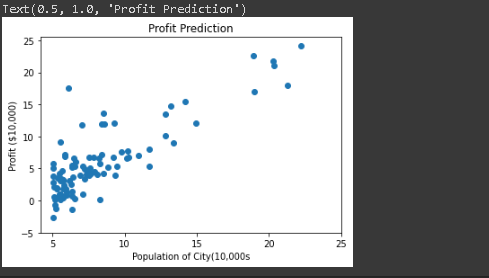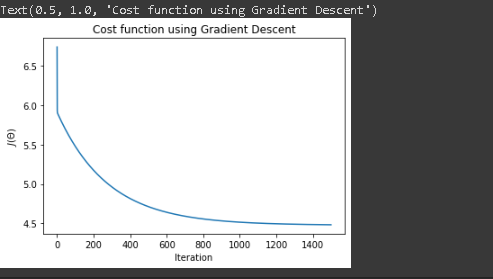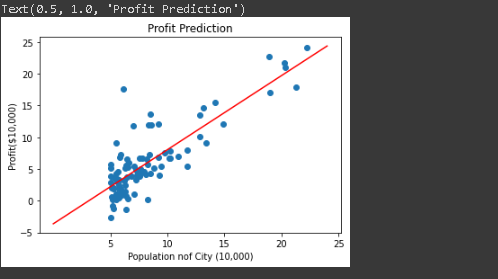To write a program to predict the profit of a city using the linear regression model with gradient descent.
- Hardware – PCs
- Anaconda – Python 3.7 Installation / Jupyter notebook
- Use the standard libraries in python for Gradient Descent.
- Upload the dataset and check any null value using .isnull() function.
- Declare the default values for linear regression
- Calculate the loss usinng Mean Square Error
- Predict the value of y.
- Plot the graph respect to hours and scores using scatter plot function.
/*
Program to implement the linear regression using gradient descent.
Developed by: Rishabendran R
RegisterNumber: 212219040121
*/
import numpy as np
import matplotlib.pyplot as plt
import pandas as pd
data = pd.read_csv("/content/ex1.txt",header=None)
plt.scatter(data[0],data[1])
plt.xticks(np.arange(5,30,step=5))
plt.yticks(np.arange(-5,30,step=5))
plt.xlabel("Population of City(10,000s")
plt.ylabel("Profit ($10,000)")
plt.title("Profit Prediction")
def computeCost(X,y,theta):
m = len(y)
h = X.dot(theta)
square_err = (h-y)**2
return 1/(2*m) * np.sum(square_err)
data_n = data.values
m = data_n[:,0].size
X = np.append(np.ones((m,1)),data_n[:,0].reshape(m,1),axis=1)
y = data_n[:,1].reshape(m,1)
theta = np.zeros((2,1))
computeCost(X,y,theta)
def gradientDescent(X,y,theta,alpha,num_iters):
m = len(y)
J_history = []
for i in range(num_iters):
predictions = X.dot(theta)
error = np.dot(X.transpose(),(predictions-y))
descent = alpha * 1/m * error
theta -= descent
J_history.append(computeCost(X,y,theta))
return theta,J_history
theta,J_history = gradientDescent(X,y,theta,0.01,1500)
print("h(x) ="+str(round(theta[0,0],2))+" + "+str(round(theta[1,0],2))+"x1")
plt.plot(J_history)
plt.xlabel("Iteration")
plt.ylabel("$J(\Theta)$")
plt.title("Cost function using Gradient Descent")
plt.scatter(data[0],data[1])
x_value = [x for x in range(25)]
y_value = [y*theta[1]+theta[0] for y in x_value]
plt.plot(x_value,y_value,color="r")
plt.xticks(np.arange(5,30,step=5))
plt.yticks(np.arange(-5,30,step=5))
plt.xlabel("Population nof City (10,000)")
plt.ylabel("Profit($10,000)")
plt.title("Profit Prediction")
def predict(X,theta):
predictions = np.dot(theta.transpose(),X)
return predictions[0]
predict1 = predict(np.array([1,3.5]),theta)*10000
print("For population = 35,000, we predict a profit of $"+str(round(predict1,0)))
predict2 = predict(np.array([1,7]),theta)*10000
print("For population = 70,000, we predict a profit of $"+str(round(predict2,0)))
Thus the program to implement the linear regression using gradient descent is written and verified using python programming.






